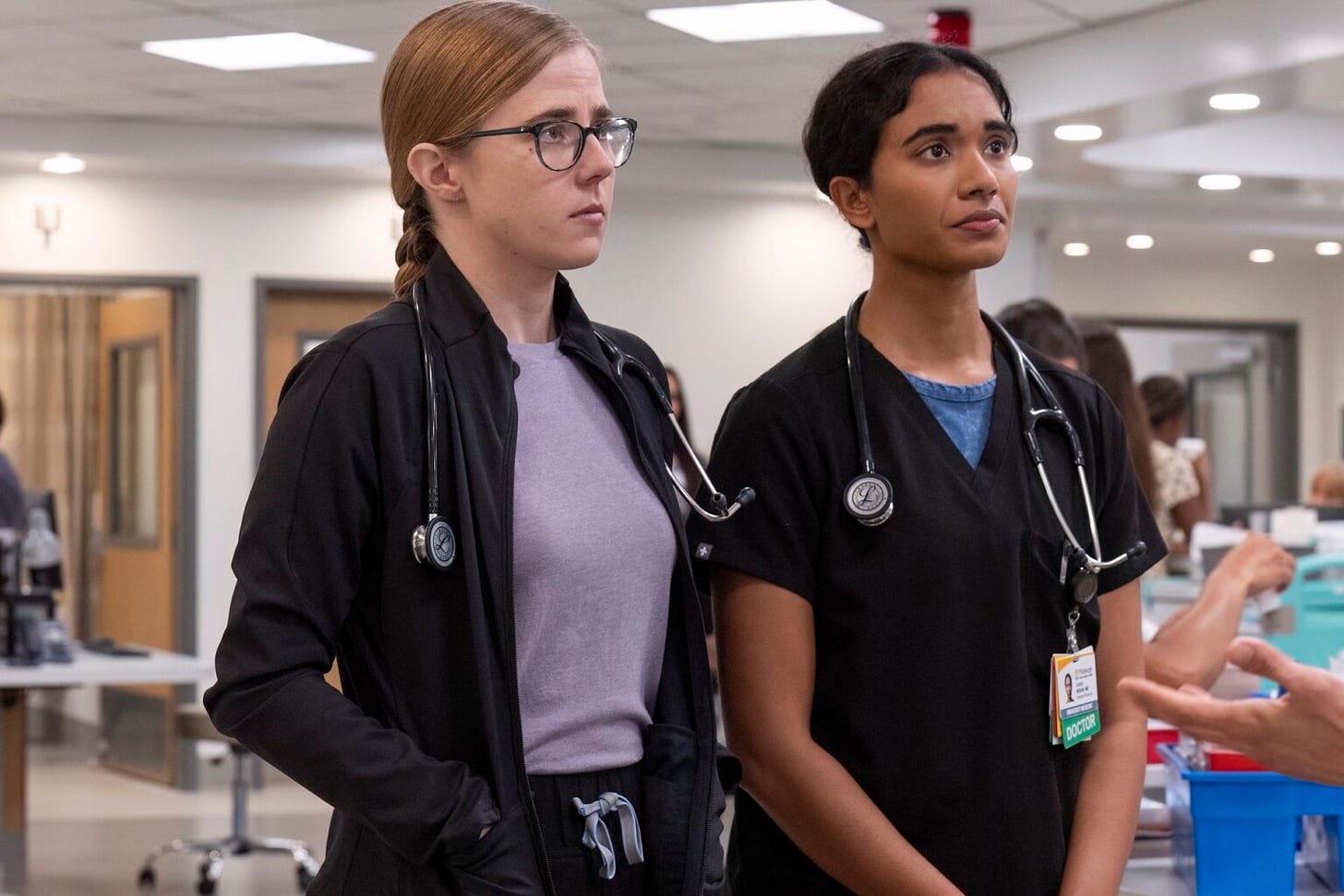I know exactly what’s going on inside emergency rooms but do you? 🤨
Major Minor Spoilers for The Pitt are below.
In today’s television landscape, it's hard not to notice that many shows seem to have lost their way. Keeping viewers engaged for an entire season is proving to be a tough task for most series in the current streaming era. From my perspective, the 2000s represented a golden era for TV, a period during which the “Big Four”1 networks, along with HBO and The WB, consistently delivered outstanding material. However, at this moment, Max's The Pitt stands out as one of the exceptions.
Pulling us right into its world, The Pitt unfolds within a beleaguered emergency department in Pittsburgh, centering on Dr. John Carter Michael “Robby” Robinavitch (Noah Wyle)2, the lead ER physician who navigates a grueling 15-hour shift that forms the backbone of the entire season. The show delivers what many contemporary medical dramas often overlook: a fast-paced plot that engages spectators while revealing the stark realities of everyday traumas. Similar to TNT’s Southland, it refrains from hand-holding you through; instead, it allows us to learn about the characters as they work to save lives, confront crises, and achieve meaningful triumphs. But the camera doesn’t solely focus on Dr. Robby; it also captures the experiences of residents and interns—some exuding confidence alongside those who struggle with self-doubt. Among them are Collins (Tracy Ifeachor), who is soon revealed to be pregnant, the clever and sharp-tongued Langdon (Patrick Ball), the endearingly awkward Melissa “Mel” King (Taylor Dearden), the brash, confrontational Santos (Isa Briones), a 20-year-old nepo baby prodigy Javadi (Shabana Azeez), and the Nebraska farm boy Dennis Whitaker (Gerran Howell).
And of course, there are the patients. Some are in and out, whereas others stay for longer durations. Take, for instance, 81-year-old memory-impaired Willie Alexander (Harold Sylvester). He’s admitted due to syncope and pacemaker-related complications. Interestingly, he served as a medic with the Freedom House Ambulance Service, an all-Black team of first responders established in 1967 in Pittsburgh. This group was instrumental in shaping emergency medical services yet their vital contributions regularly go unrecognized. “That’s incredible…That guy’s a legend,” Dr. Robby says with a smile.
But the true highlight of the show is its unyielding tempo. The Pitt buzzes with weltering energy matching the rapid flow of a Future verse or the brisk dialogue of an Aaron Sorkin walk and talk. The action unfolds so swiftly that a 50-minute episode feels like it passes in just 20, leaving you on the edge of your seat, anxiously asking, “What? When is the next episode coming?!” In short, catch it or it’ll go Houdini.
I found The Pitt quite binge-worthy, though. With a total of 15 episodes and the Season 1 finale set to air on April 10 (*prayer hands emoji*), it may very well be the first medical drama that compels me to watch it again just to see how they execute their narrative. Despite Dr. Robby’s less-than-stellar patient satisfaction ratings, he remains composed, even on his toughest shift. He approaches the grieving parents of a college student who succumbed to an accidental fentanyl overdose with remarkable empathy. In fact, he conducts unnecessary tests to ease their pain. He extends this same compassionate approach to two adult siblings grappling with the heart-wrenching decision of taking their elderly father off life support. Dr. McKay (Fiona Dourif) opens up about her own battles with addiction to connect with a homeless patient, fostering trust. Meanwhile, Dr. Mohan (Supriya Ganesh) takes the time to listen to a bewildered makeup influencer, successfully preventing a misdiagnosis of schizophrenia and discovering that the young woman is actually suffering from mercury poisoning due to her cosmetics. What I’m getting at is this: The bona fide mark of virtuoso expertise in this context is not only the doctors' capacity for accurate diagnoses, but also their recognition that patients are unique individuals deserving of benevolence, rather than mere cases to be addressed.
Amidst all the chaos that envelops the bustling hospital, there are still jocose moments that bring a touch of goofiness to the day’s intensity. Like, (poor) Whitaker who finds himself in an ongoing struggle with his scrubs getting doused in something gross and being forced to get another pair from the scrubEx machine over and over again. This happens so frequently that you can easily picture Whitaker standing there, a blend of languor and vexation etched across his face, while he waits for a clean set of scrubs—or (alternatively), for a Nickelodeon-style slime volley—before heading back to his patients.
I can’t say for certain whether The Pitt will reach the legendary heights of ER, yet it undeniably captures the essence of its genre, offering a nostalgic allure that draws viewers in and keeps them coming back. Essentially, it’s very good television that is conveniently accessible on a streaming platform. There’s always a chance where it could falter but I have to say it is still thrilling to see a show exude a timeless enthusiasm for the art of storytelling.
The Pitt is currently streaming on Max. New episodes release on Thursday.
NBC, CBS, ABC, and Fox.






You never miss